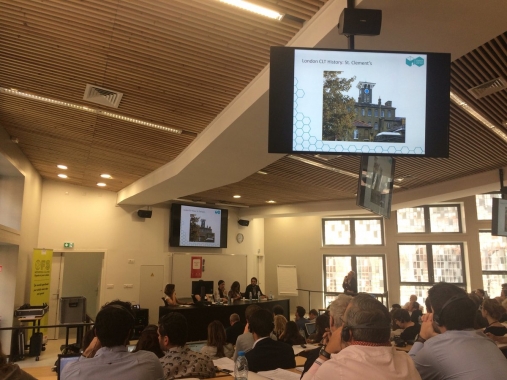Community Land Trusts: a model for permanently affordable housing in European cities?
First transnational meeting of the SHICC project held in Lille
Lille, 1 June 2018
"Community Land Trusts: a model for permanently affordable housing in Europe a cities?" was the question du jour at the transnational kick-off conference for INTERREG North-West Europe's project Sustainable Housing for Inclusive and Cohesive Cities (SHICC) held in Lille, France on May 22nd.
Representatives from CLT Brussels, CLT Ghent, Ville CLT, Bristol CLT, London CLT, Ville de Lille, French Notary Council, the French Ministry of Housing, National CLT Network UK, Fédération des coopératives HLM, and others shared their experience and knowledge to a large crowd of attendees in the Sciences Po Lille building.
Indeed, representatives from the four pilot project CLTs were very pleased to share their experiences - in terms of the origin story of each project, how they secured financing, what the legal and regulatory framework looked like and how it has developed, and how engagement with candidate residents operates.
London CLT told of how their project grew out of the community organising efforts of Citizens UK, a national umbrella group for community organisers, in response to the need for genuinely affordable homes in the capital. It was during the time of the Olympics bid, and the community organisers managed to negotiate a deal for a CLT. London CLT now consists of 2,600 invididuals, operate on prices being linked to median income, re-sale value covenants and allocation criteria of proving a local connection. One project is near completion and there is a second on the way.
Ghent and Lille both said they drew inspiration from Brussels, who recognised the housing issue, discovered the CLT model, supported the coming together of associations, which lead to the creation of a charter and a CLTB platform. In September 2015, the L'Ecluse project became the first inhabited CLT in continental Europe. Fast forward to today, and CLTB have 6 more projects in progress and another 6 in preparation.
The Ghent development started with the writing up of a charter, with a trust being created in 2017, in which candidate residents were involved. During a workshop on "Building a genuinely community-led CLT", workers from Ghent CLT shared how a design competition was held, in whcih candidate residents were involved in decision-making rounds. In the lead up to the completion of the built structures, candidate residents are also involved with a community garden and regular events and activities.
Lille, the fourth most expensive city in France, has two ongoing projects, the Cosmopole operation and Renan St operation. Audrey Linkenheld, Lille Local Councillor and co-author of the legislation on French OFS/CLT model, spoke about how this "disassociating the land from the walls" is a real social innovation, one that was translated from the local level into national law.
One major takeaway of the day was the fact of how there genuinely is no one correct model of CLT ("there is no 'right' way, and no 'right' time"). Whether related to projection initiation and management (local authority led or "bottom up development"), financing model, the actual built structure, make-up of residents (what percentage from social housing waiting list, which types of tenures i.e. rental, home-ownership, convenant lease), size of service area (some CLTs in the United States comprise of between 500,000 to 6 million people!) - every CLT is different, and this type of flexibilty is one of its advantages.
However, all concurred that the basic elements of CLT can be understood as "a community led development, on community own land (via a trust), for permanent affordable housing". The trust is a non-profit owner, a steward of the land and community.
John Davis of Burlington CLT, an academic, long-time CLT advocate and community organiser, went further and said that we must not forget that a complete urban economy is necessary, one that features communal spaces and public facilities, and "not just housing".
Read MoreAnother commonality that came out through discussions was the very real desire for these types of developments, coming from local authorities, community groups and civil society, and individuals and families facing housing difficulty or exclusion - the biggest indicator of this being the fact that most CLTs have very long waiting lists, too many candidates for too few spaces. One CLT worker commented on how she had heard of one particularly democratic and transparent method of selecting the final residents: random lottery.
It was noted how, a decade ago, there were only a handful of CLTs spread across Europe. Today, there are 245 in England and Wales, and 33 in North-West Europe region. In fact, the INTERREG project aims to scale up to 500 CLTs, consisting of 7,000 dwellings for 21,000 people. SHICC seeks to support the establishment of more successful CLTs in cities across the NEW region. Over the three-year project, it will invest in the four existing pilot CLTs in Brussels, Ghent, Lille and London to "prove the concept", create a supportive local, national and regional policy, funding and regulatory environment for CLTs and a build a movement across the region.
Attendees at the 2-day conference commented how that by the end of it, "there was a real buzz and optimism in the air for what this project could achieve. This feeling was bolstered by new transnational relationships being built and existing ones being strengthened."
Housing Europe is interested in supporting the consortium with the preparation of EU policy recommendations, by disseminating the project developments and by making the link with public, cooperative and social housing providers that take relevant initiatives.